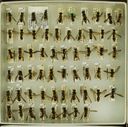Vespidae
Vespidae
Classification
- Phylum: Arthropoda
- Subphylum: Hexapoda
- Class: Insecta
- Order: Hymenoptera
- Superfamily: Vespoidea
- Family: Vespidae
Pronunciation
How to pronounce Vespidae: //ˈvɛspɪdiː//
These audio files are automatically generated. While they are not always 100% accurate, they are a good starting point.
Images






Summary
Vespidae is a large and diverse family of wasps, encompassing nearly all known eusocial wasps and many solitary wasps. They play significant roles in ecosystems as predators and pollinators.
Physical Characteristics
Mandibles with a cutting/chewing surface near the apex rather than along the inner margin. Nests constructed out of mud, plant fibers, or chewed material that resembles paper.
Identification Tips
Social vespids can be distinguished from nonsocial ones by their mandible structure and social behavior.
Habitat
Found in diverse habitats worldwide, with nests built in various sheltered locations depending on species.
Distribution
Approximately 5,000 species in around 270 genera globally, with around 300 species across 36 genera in specific areas (like Northeastern US).
Diet
Eumeninae, Euparagiinae, and Masarinae feed on pollen and nectar; Polistinae and Vespinae collect various arthropods and carrion for their young, which are then premasticated and fed to the larvae.
Life Cycle
In temperate social species, colonies last usually one year, dying at winter's onset. New queens and drones produced late summer; queens hibernate during winter.
Reproduction
Eusocial species have a queen and multiple female workers with varying degrees of sterility; solitary species may have varying reproductive strategies.
Ecosystem Role
Potential or effective pollinators for several plant species and predators of pest insect species; some species can be invasive pests.
Collecting Methods
- Netting
- Bait trapping
Preservation Methods
- Pinning
- Ethanol preservation
- Heat fixation
Evolution
Fossils known from the Early Cretaceous period; evolutionary history includes both solitary and social forms.
Similar Taxa
Misconceptions
Some species are often mistakenly considered pests while others provide important ecological services as pollinators and pest predators.
Tags
- wasps
- Vespidae
- insects
- hymenoptera
- eusocial
- solitary